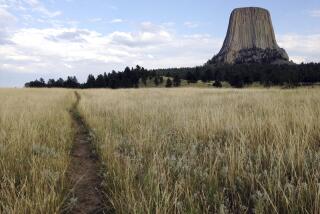Sighting Puts Shuttle Watcher in Spotlight
Anthony Beasley is a stargazer turned something of a reluctant star.
The Caltech astronomer quietly built a career scanning the heavens with highly sophisticated radio telescopes. Then a strange phenomenon he spotted with the naked eye -- troubling bursts of light high above the Sierra Nevada -- landed him on front pages around the globe. He became a celebrity of sorts.
Beasley filed the first widely circulated report suggesting that the space shuttle Columbia shed fiery debris as it streaked over California. Initially, harried NASA officials dismissed his account. The Columbia started to break up in the skies above Texas, they said. Beasley must have been mistaken.
NASA reversed itself in short order as more witnesses’ reports and other information came in. The agency subsequently expanded its hunt for shuttle wreckage to California’s broad elbow, a needle-in-the-haystack search that continues.
“I was pretty certain of what I had seen,” the Australian-born Beasley, 37, said in his office at Caltech’s Owens Valley Radio Observatory. “I clearly saw something detach from the orbiter.”
His conviction, along with his credentials, thrust him into the spotlight even before NASA gave his story a second look. Media calls jammed the phone lines at the observatory and Beasley’s home in nearby Bishop. Television networks put him on the air. Newspapers, wire services and magazines sought interviews.
“It was pretty intense,” he said. “I dealt with it as best I could.... I had 100 calls the first day. My wife was pretty [mad].”
Australian reporters were particularly dogged. “They pumped it up a little because there was an Aussie connection,” Beasley said. “I heard from back home -- family, people I went to school with. I was just kind of a public event.”
The onslaught has eased but hasn’t stopped. Beasley’s e-mail basket brims with messages whose senders range from thoughtful space enthusiasts to conspiracy cranks.
“I’m getting a whole lot of weird ones,” he said. “They’ll say, ‘I had a dream that the shuttle was destroyed by this or that.’ ”
Beasley had no inkling of destruction when he watched the shuttle soar over the Sierra, despite the unusual flashes that seemed to mark its wake, like flares dropping.
He had learned from two photographers that the Columbia would be visible above the Owens Valley during its Feb. 1 descent. They had arranged to photograph it from the observatory.
“I wouldn’t have known the shuttle was going over if these guys didn’t call up,” Beasley said. “I thought it would be a cool thing to see.”
So he woke before dawn, roused his wife and mother-in-law, and marched them out to the driveway. They had the street to themselves; it was Saturday, and folks were sleeping in. Only the burbling of a creek disturbed the quiet. The snowy Sierra rose in the distance.
In the retreating darkness, the shuttle cut a bright arc across the northern sky. Beasley noticed two small points of light falling away from the craft -- then a much larger one. Anne Beasley and her mother, Anne Finley, saw them too.
“I asked him what it was, and he said, ‘Tiles,’ ” recalled Anne Beasley, referring to the insulation tiles that protect the shuttle from heat on reentry.
Her husband knew that the shuttle frequently loses some tiles on the return to Earth. One focus of NASA’s investigation is whether a large number of tiles tore off Columbia, exposing it to catastrophic heat.
“The thing that struck me is that the orbiter just kept going -- it was going really fast, and it looked like it was fine,” the scientist said. “It was a real shock to me when I heard 45 minutes later that it exploded.”
That news prompted him to draft an e-mail for his bosses at Pasadena’s Caltech, recounting what he saw in scientific detail.
“He’s very concerned about details,” said Anneila Sargent, director of the Owens Valley observatory. “He’s that kind of person: very thoughtful and very responsible. He immediately sat down and wrote a report about what he saw.”
Even as Caltech forwarded the report to NASA -- “We believe it can be helpful,” said agency spokesman John Ira Petty -- word got out and the calls flooded in. Beasley took fewer and fewer of the calls. He concentrated on his work.
Radio telescopes capture images invisible to the naked eye -- stars forming, galaxies being born. Beasley studies them in wonder. But they can’t compete with what he saw from the driveway. “That was something people have never seen before,” he said. “And it was tragic.”
More to Read
Sign up for Essential California
The most important California stories and recommendations in your inbox every morning.
You may occasionally receive promotional content from the Los Angeles Times.











